Work-Related Musculoskeletal Disorders of Dance Teachers in Germany: A Retrospective Cross-Sectional Study
Abstract
1. Introduction
2. Materials and Methods
2.1. Study Design and Study Population
- at least 18 years of age;
- working as a DT is the main profession (financial livelihood);
- employed and/or freelance;
- focusing on theatrical dance (mainly classical dance (ballet), modern and jazz dance, or contemporary dance);
- teaching nonprofessional and/or (pre-)professional students;
- resident in Germany.
2.2. Work-Related Musculoskeletal Disorders Definition
2.3. Questionnaire Design and Main Outcome Parameters
2.4. Testing Procedure
2.5. Data Analysis and Statistical Analysis
3. Results
3.1. Sample Characteristics
3.2. WMSD Occurrence
3.3. WMSD Localisation
3.4. Affected Tissues
3.5. Subjective Cause Attribution
4. Discussion
5. Conclusions
Author Contributions
Funding
Institutional Review Board Statement
Informed Consent Statement
Data Availability Statement
Conflicts of Interest
References
- Mölders, C.; Wanke, E.M. Wie gesund sind Bewegungen vermittelnde Berufsgruppen? Zbl. Arbeitsmed. 2019, 69, 230–235. [Google Scholar] [CrossRef]
- Wanke, E.M.; Schmidt, M.; Leslie-Spinks, J.; Fischer, A.; Groneberg, D.A. Physical and Mental Workloads in Professional Dance Teachers. Med. Probl. Perform. Art. 2015, 30, 54–60. [Google Scholar] [CrossRef] [PubMed]
- Schmidt, M.; Ohlendorf, D.; Groneberg, D.A.; Wanke, E.M. Fit to Teach?—Cardiorespiratory Capacity, Vitamin D3, and Ferritin in Physical Education Teachers with Specialization in Dance. J. Strength Cond Res. 2021, 35, 1156–1164. [Google Scholar] [CrossRef]
- Schmidt, M.; Ohlendorf, D.; Reer, R.; Groneberg, D.A.; Wanke, E.M. Job-Related Satisfaction and Health Perception of Dance Teachers. Zbl. Arbeitsmed. 2021, 71, 109–117. [Google Scholar] [CrossRef]
- Dahlström, M. Physical Effort During Dance Training: A Comparison between Teachers and Students. J. Dance Med. Sci. 1997, 1, 143–148. [Google Scholar]
- Wanke, E.M.; Schmidt, M.; Oremek, G.; Groneberg, D.A. Work Related Cardiovascular Load in Professional Dance Teachers–a Pilot Study. J. Occup. Med. Toxicol. 2020, 15, 7. [Google Scholar] [CrossRef]
- Erick, P.N.; Smith, D.R. A Systematic Review of Musculoskeletal Disorders among School Teachers. BMC Musculoskelet. Disord. 2011, 12, 260. [Google Scholar] [CrossRef]
- Lemoyne, J.; Laurencelle, L.; Lirette, M.; Trudeau, F. Occupational Health Problems and Injuries among Quebec’s Physical Educators. Appl. Ergon. 2007, 38, 625–634. [Google Scholar] [CrossRef]
- Kovač, M.; Leskošek, B.; Hadžić, V.; Jurak, G. Injuries Among Slovenian Physical Education Teachers: A Cross-Sectional Study. Int. J. Occup. Saf. Ergon. 2013, 19, 87–95. [Google Scholar] [CrossRef]
- Goossens, L.; Vercruysse, S.; Cardon, G.; Haerens, L.; Witvrouw, E.; De Clercq, D. Musculoskeletal Injuries in Physical Education versus Non-Physical Education Teachers: A Prospective Study. J. Sports Sci. 2016, 34, 1107–1115. [Google Scholar] [CrossRef]
- Lampe, J.; Groneberg, D.A.; Ohlendorf, D.; Wanke, E.M. Pain in Female Dancers and Dance Teachers: Perception, Assessment, and Related Behavior. Scand. J. Med. Sci. Sport. 2019, 29, 623–632. [Google Scholar] [CrossRef] [PubMed]
- Jacobs, C.L.; Hincapié, C.A.; Cassidy, J.D. Musculoskeletal Injuries and Pain in Dancers: A Systematic Review Update. J. Dance Med. Sci. 2012, 16, 74–84. [Google Scholar] [PubMed]
- Allen, N.; Ribbans, W.; Nevill, A.; Wyon, M. Musculoskeletal Injuries in Dance: A Systematic Review. Int. J. Phys. Med. Rehabil. 2014, 03, 1–8. [Google Scholar]
- Smith, P.J.; Gerrie, B.J.; Varner, K.E.; McCulloch, P.C.; Lintner, D.M.; Harris, J.D. Incidence and Prevalence of Musculoskeletal Injury in Ballet. Orthop. J. Sports Med. 2015, 3, 232596711559262. [Google Scholar] [CrossRef]
- Smith, T.O.; Davies, L.; De Medici, A.; Hakim, A.; Haddad, F.; Macgregor, A. Prevalence and Profile of Musculoskeletal Injuries in Ballet Dancers: A Systematic Review and Meta-Analysis. Phys. Ther. Sport 2016, 19, 50–56. [Google Scholar] [CrossRef]
- Cardoso, A.A.; Reis, N.M.; Marinho, A.P.R.; Vieira, M.; de Carvalho Souza Vieira, M.; Boing, L.; de Azevedo Guimarães , A.C. Injuries in Professional Dancers: A Systematic Review. Rev. Bras. Med. do Esporte 2017, 23, 504–509. [Google Scholar] [CrossRef]
- Vassallo, A.J.; Trevor, B.L.; Mota, L.; Pappas, E.; Hiller, C.E. Injury Rates and Characteristics in Recreational, Elite Student and Professional Dancers: A Systematic Review. J. Sports Sci. 2019, 37, 1113–1122. [Google Scholar] [CrossRef]
- Podniece, Z.; Heuvel, S.; Blatter, B. Work-Related Musculoskeletal Disorders: Prevention Report; European Agency for Safety and Health at Work: Bilbao, Spain, 2008. [Google Scholar]
- Wanke, E.M.; Clausen, K.; McCormack, M.; Groneberg, D.A. Work-Related Health Problems in Dance Teachers—A Pilot Study. Mo. J. Health Phys. Educ. Recreat. Dance 2014, 24, 55–66. [Google Scholar]
- Kuorinka, I.; Jonsson, B.; Kilbom, A.; Vinterberg, H.; Biering-Sørensen, F.; Andersson, G.; Jørgensen, K. Standardised Nordic Questionnaires for the Analysis of Musculoskeletal Symptoms. Appl. Ergon. 1987, 18, 233–237. [Google Scholar] [CrossRef]
- Liederbach, M.; Hagins, M.; Gamboa, J.M.; Welsh, T.M. Assessing and Reporting Dancer Capacities, Risk Factors, and Injuries: Recommendations from the IADMS Standard Measures Consensus Initiative. J. Dance Med. Sci. 2012, 16, 139–153. [Google Scholar]
- Cohen, J. Statistical Power Analysis for the Behavioral Science, 2nd ed.; Lawrence Erlbaum Associates: New York, NY, USA, 1988. [Google Scholar]
- Eurostat. Accidents at Work and Other Work-Related Health Problems. 2020. Available online: https://ec.europa.eu/eurostat/databrowser/view/HSW_PB5__custom_1708329/default/table?lang=en (accessed on 10 December 2021).
- Wanke, E.M.; Quarcoo, D.; Uibel, S.; Groneberg, D.A. Arbeitsunfälle Bei Bewegung Vermittelnden, Angestellten Lehrkräften. Evaluation Am Beispiel der Tanzpädagogik. Trauma Berufskrankh. 2012, 14, 46–50. [Google Scholar] [CrossRef]
- Wanke, E.M.; Arendt, M.; Mill, H.; Groneberg, D.A. Occupational Accidents in Professional Dance with Focus on Gender Differences. J. Occup. Med. Toxicol. 2013, 8, 2–8. [Google Scholar] [CrossRef] [PubMed]
- Costa, M.S.S.; Ferreira, A.S.; Orsini, M.; Silva, E.B.; Felicio, L.R. Characteristics and Prevalence of Musculoskeletal Injury in Professional and Non-Professional Ballet Dancers. Braz. J. Phys. Ther. 2016, 20, 166–175. [Google Scholar] [CrossRef] [PubMed]
- Descatha, A.; Roquelaure, Y.; Chastang, J.F.; Evanoff, B.; Melchior, M.; Mariot, C.; Ha, C.; Imbernon, E.; Goldberg, M.; Leclerc, A. Validity of Nordic-Style Questionnaires in the Surveillance of Upper-Limb Work-Related Musculoskeletal Disorders. Scand. J. Work. Environ. Health 2007, 33, 58–65. [Google Scholar] [CrossRef]
- Thomas, H.; Tarr, J. Dancers’ Perceptions of Pain and Injury. J. Dance Med. Sci. 2009, 13, 51–59. [Google Scholar]
- Mainwaring, L.M.; Finney, C. Psychological Risk Factors and Outcomes of Dance Injury. J. Dance Med. Sci. 2017, 21, 87–96. [Google Scholar] [CrossRef]
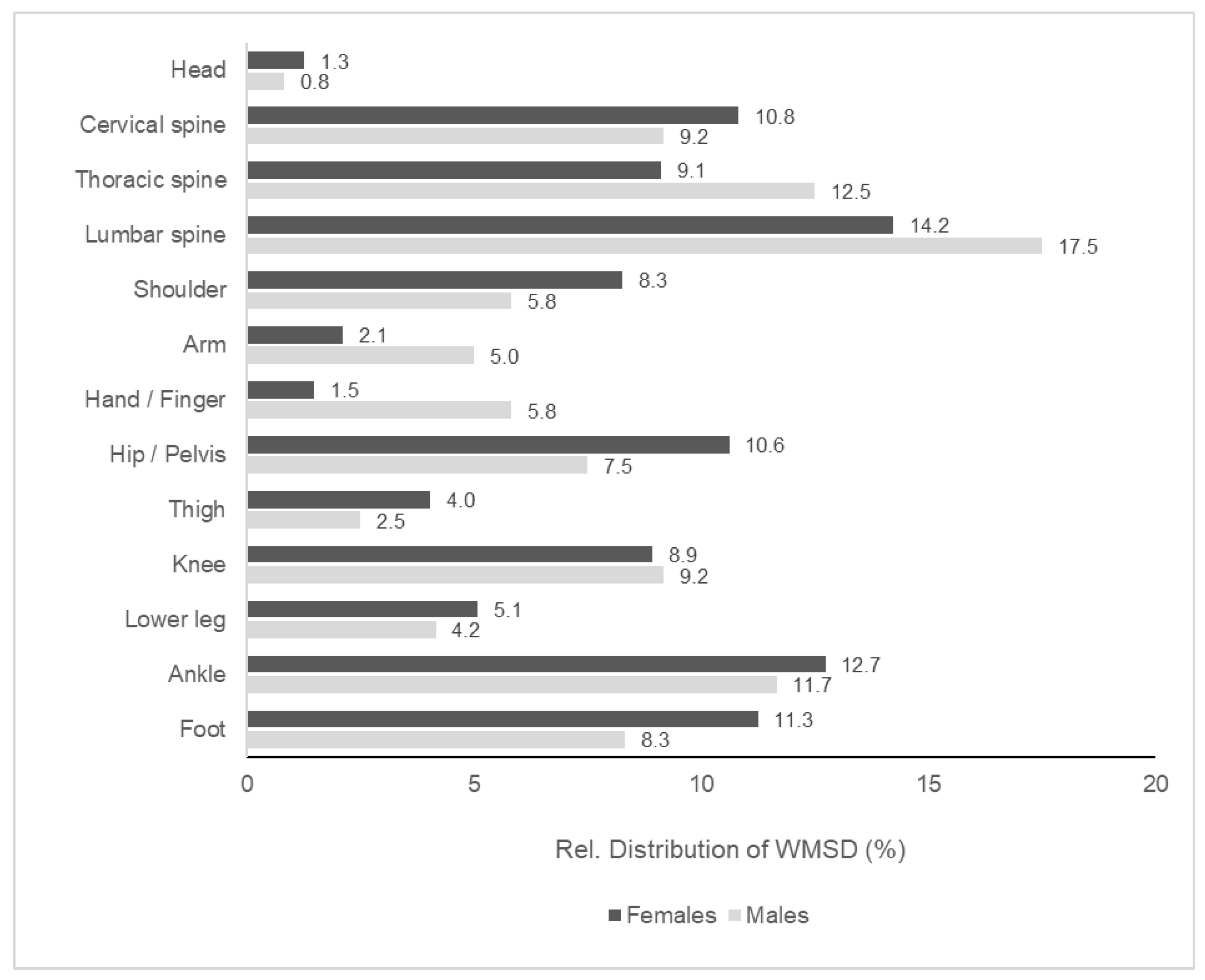
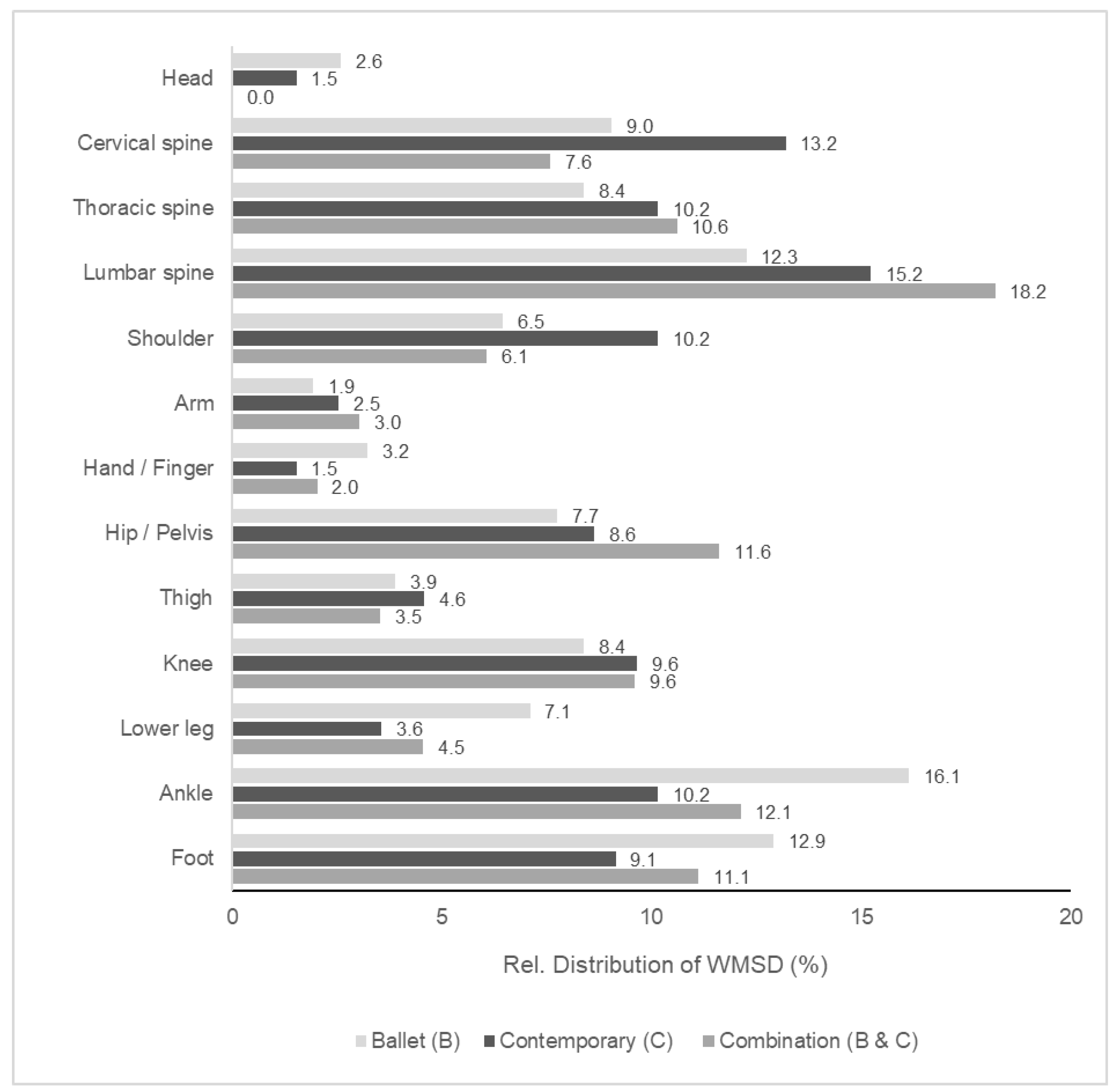
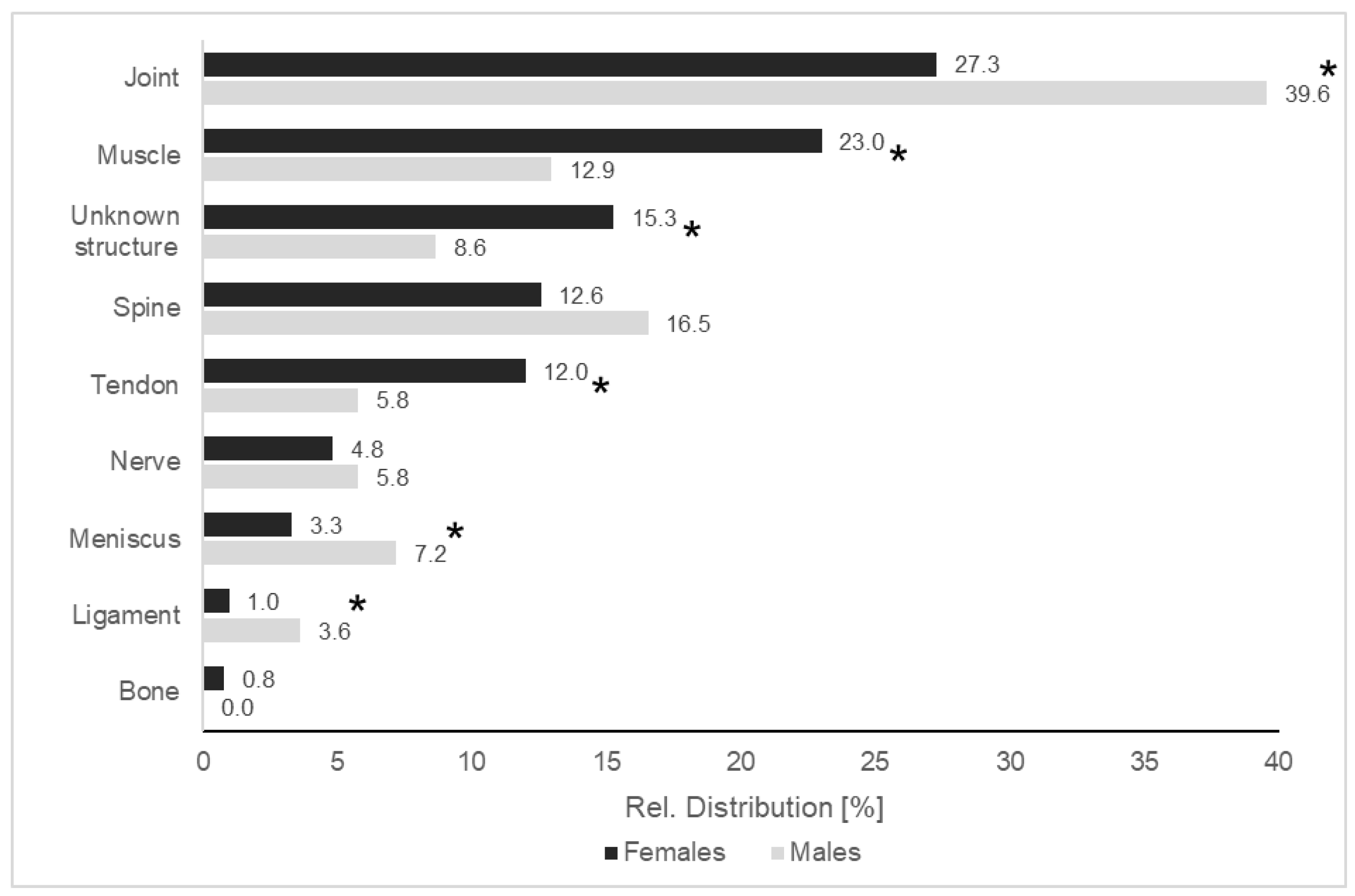
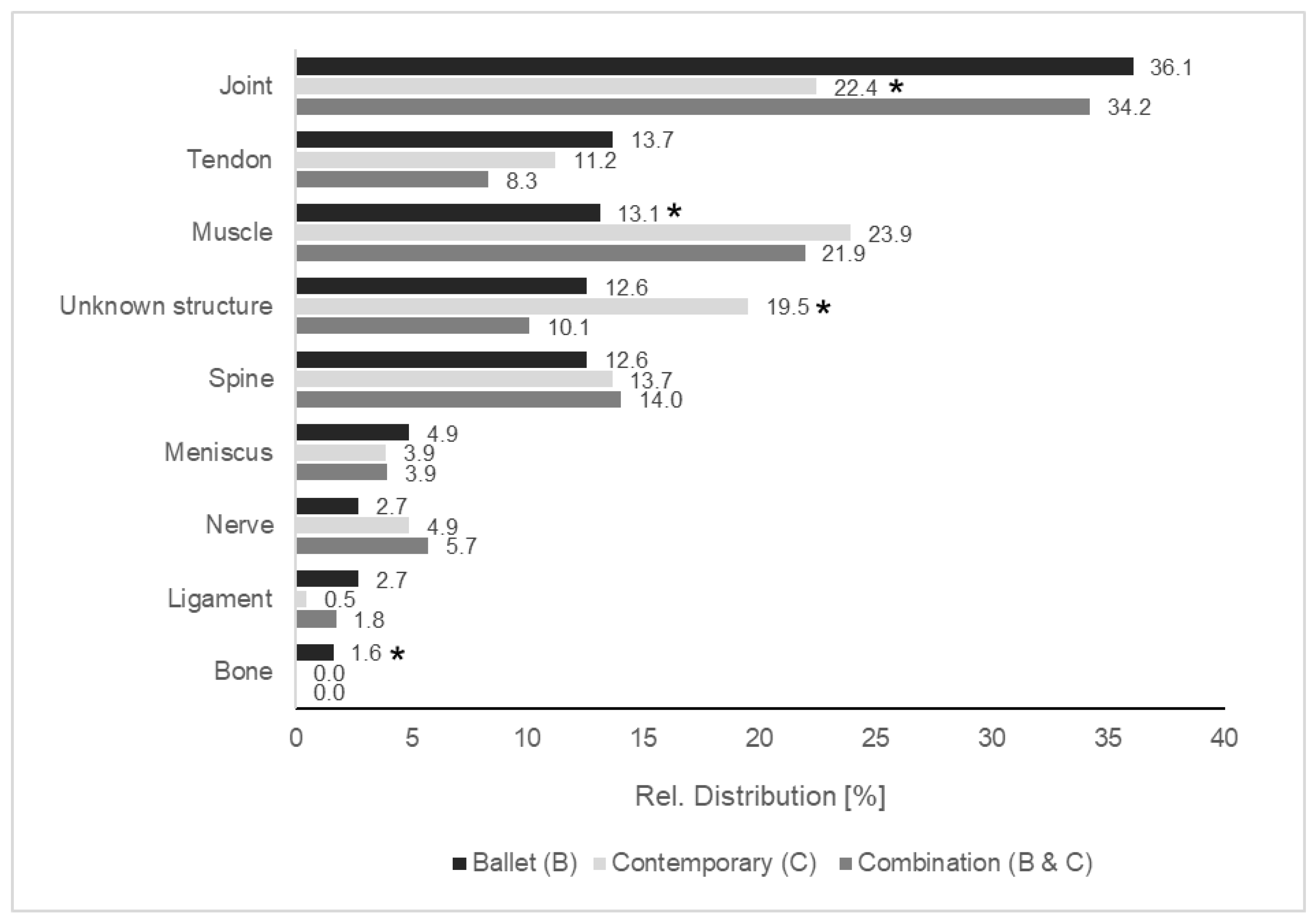
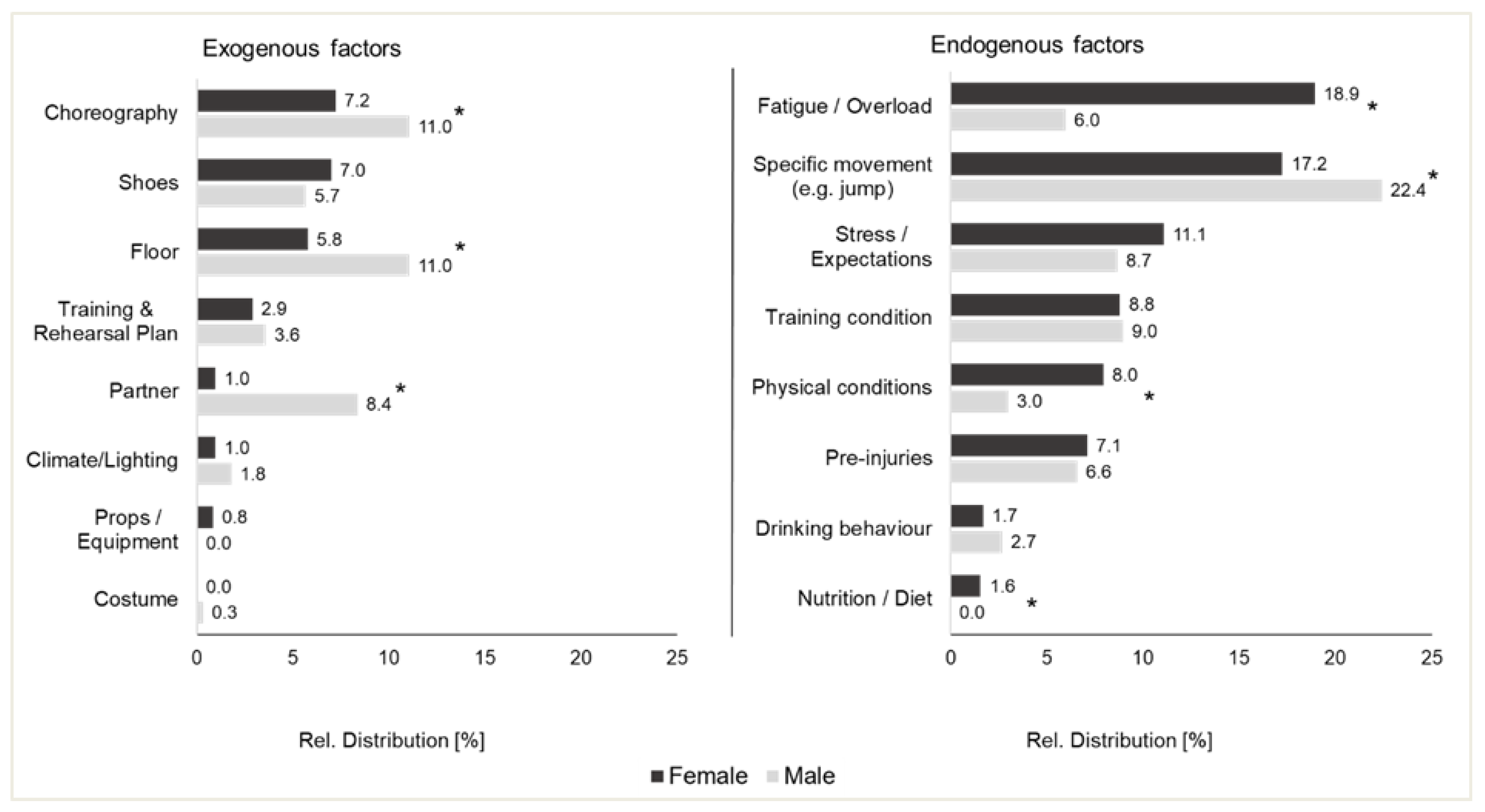
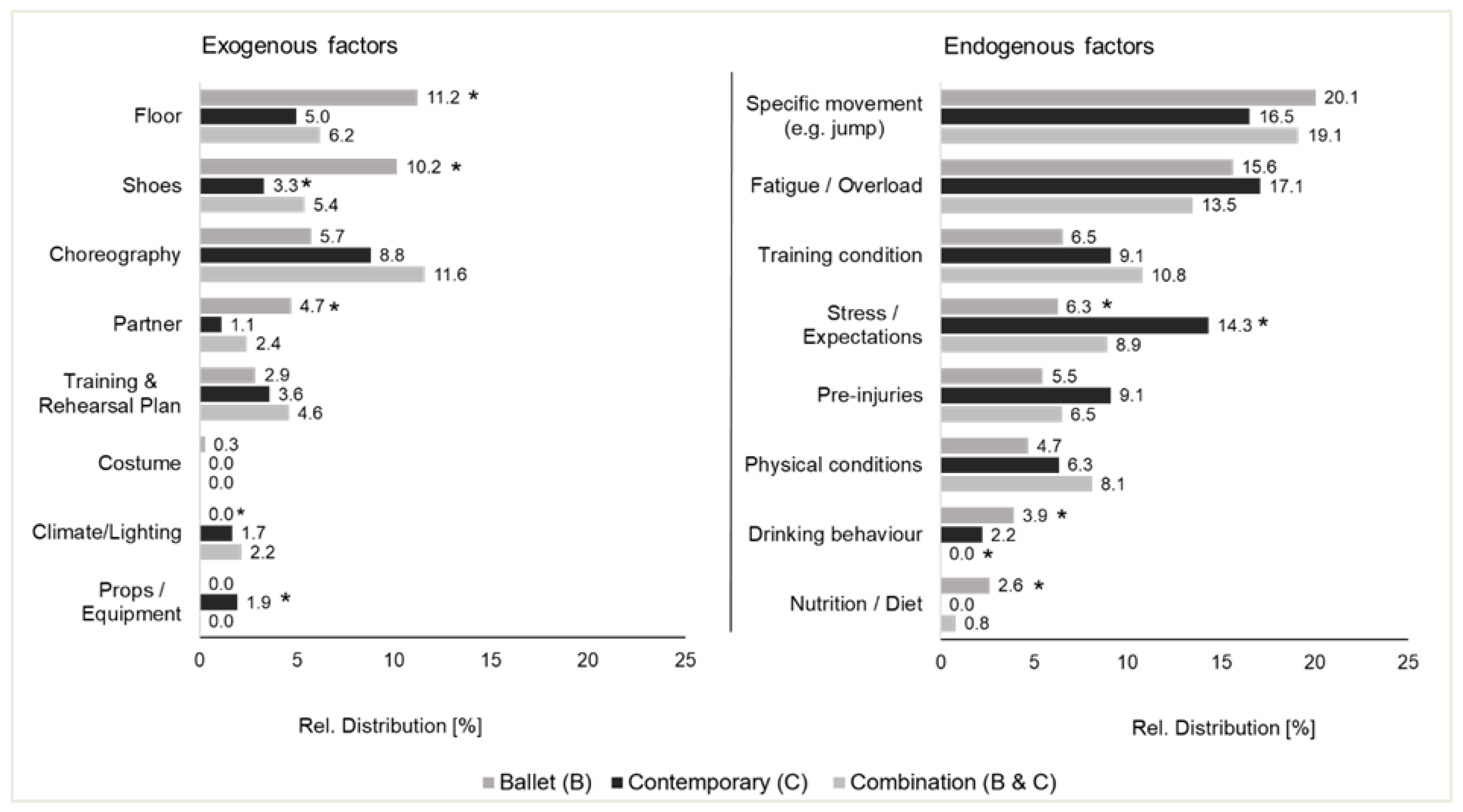
| n | Mean | SD | Range | Z-Score | p-Value | Effect Size r | |
|---|---|---|---|---|---|---|---|
| Age (yrs) | |||||||
| Total | 229 | 43.1 | 11.0 | 22.0–77.0 | |||
| Females | 181 | 42.0 | 10.5 | 22.0–68.0 | −2.278 | 0.023 * | 0.151 |
| Males | 48 | 47.1 | 12.2 | 22.0–77.0 | |||
| Height (cm) | |||||||
| Total | 229 | 170.0 | 7.7 | 145.0–195.0 | |||
| Females | 181 | 167.8 | 6.2 | 145.0–183.0 | −7.763 | <0.000 * | 0.513 |
| Males | 48 | 178.0 | 7.5 | 156.0–195.0 | |||
| Weight (kg) | |||||||
| Total | 229 | 61.6 | 10.7 | 40.0–100.0 | |||
| Females | 181 | 58.3 | 8.2 | 40.0–89.0 | −8.384 | <0.000 * | 0.554 |
| Males | 48 | 74.2 | 9.8 | 54.0–100.0 | |||
| BMI (kg *m−2) | |||||||
| Total | 229 | 21.2 | 2.7 | 17.0–33.0 | |||
| Females | 181 | 20.7 | 2.4 | 17.0–33.0 | −6.610 | <0.000 * | 0.437 |
| Males | 48 | 23.4 | 2.6 | 19.0–31.0 | |||
| Teaching experience (yrs) | |||||||
| Total | 227 | 14.0 | 10.0 | 1.0–41.0 | |||
| Females | 180 | 14.0 | 10.3 | 1.0–41.0 | −0.077 | 0.938 | 0.005 |
| Males | 47 | 13.9 | 9.2 | 1.0–40.0 | |||
| Weekly teaching time (hrs) | |||||||
| Total | 203 | 18.4 | 10.1 | 2.0–50.0 | |||
| Females | 166 | 18.0 | 9.5 | 2.0–44.0 | −0.444 | 0.657 | 0.031 |
| Males | 37 | 20.0 | 12.4 | 3.0–50.0 |
Disclaimer/Publisher’s Note: The statements, opinions and data contained in all publications are solely those of the individual author(s) and contributor(s) and not of MDPI and/or the editor(s). MDPI and/or the editor(s) disclaim responsibility for any injury to people or property resulting from any ideas, methods, instructions or products referred to in the content. |
© 2023 by the authors. Licensee MDPI, Basel, Switzerland. This article is an open access article distributed under the terms and conditions of the Creative Commons Attribution (CC BY) license (https://creativecommons.org/licenses/by/4.0/).
Share and Cite
Schmidt, M.; Reer, R.; Groneberg, D.A.; Holzgreve, F.; Wanke, E.M. Work-Related Musculoskeletal Disorders of Dance Teachers in Germany: A Retrospective Cross-Sectional Study. Appl. Sci. 2023, 13, 1454. https://doi.org/10.3390/app13031454
Schmidt M, Reer R, Groneberg DA, Holzgreve F, Wanke EM. Work-Related Musculoskeletal Disorders of Dance Teachers in Germany: A Retrospective Cross-Sectional Study. Applied Sciences. 2023; 13(3):1454. https://doi.org/10.3390/app13031454
Chicago/Turabian StyleSchmidt, Mike, Rüdiger Reer, David A. Groneberg, Fabian Holzgreve, and Eileen M. Wanke. 2023. "Work-Related Musculoskeletal Disorders of Dance Teachers in Germany: A Retrospective Cross-Sectional Study" Applied Sciences 13, no. 3: 1454. https://doi.org/10.3390/app13031454
APA StyleSchmidt, M., Reer, R., Groneberg, D. A., Holzgreve, F., & Wanke, E. M. (2023). Work-Related Musculoskeletal Disorders of Dance Teachers in Germany: A Retrospective Cross-Sectional Study. Applied Sciences, 13(3), 1454. https://doi.org/10.3390/app13031454







